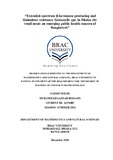Extended-spectrum β-lactamase producing and Quinolone resistance Salmonella spp. in Dhaka city retail meat: an emerging public health concern of Bangladesh

View/Open
Date
2018-12Publisher
Brac UniversityAuthor
Hossain, Muhammad SazzadMetadata
Show full item recordAbstract
Salmonella has represented as the primary cause of food poisoning in human. Immunocompromised people and infants are mainly vulnerable to salmonellosis; Salmonella can be found in many foods and food products including retail meat. Multi-drug resistance Salmonella has posed a robust challenge to food safety. Periodically, from March 2015 to December 2015,328 samples were collected from 10 live animal market (LAM) from Dhaka city in Bangladesh. In this study,15% (n=48) samples (13% chicken meat, 13% beef, 28% mutton, and 40% buffalo) were found to be Salmonella spp. positive. From (n=48) Salmonella isolates,58% nontyphoidal and 42% typhoidal Salmonella spp. were observed among the meat samples. A total of 13 antibiotics of β-lactam and Quinolone groups were tested to determine antibiotic resistance profile by using the Bauer method. Resistance to at least four antibiotic agents was detected in 100% (n=48) of isolates and the most extremely resistance were observed to Pefloxacin 100%, Enrofloxacin 78%, Nalidixic acid 74%, Ciprofloxacin 67% and ampiciline 58%. However, Ceftriaxone 4%, Cefixime 7%, Cefepime 9% and Imipenem 11% was shown relatively low antibiotic resistant. Presence of ESBLs (Extended-spectrum beta-lactamases) gene blaTEM 89% was remarkable, another gene bla IMP 29%, bla VIM 29%, bla CTX-M 27%, bla OXA 20% and bla KPC 11% was observed along or various combination. GyrA and GyrB was simultaneously observed in highly resistance quinolone antibiotics. Quinolone antibiotic resistance gene (GyrA 80%, GyrB 23% and parc 20%) was observed in phenotypic resistance isolate alone or concurrently. Resistant strains of Salmonella are common in retail meat, may be prudent use of antibiotics in livestock can mitigate this problem.
